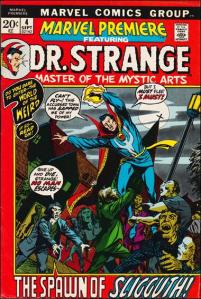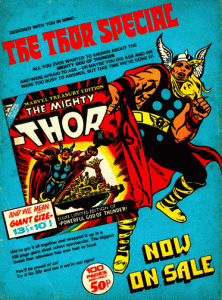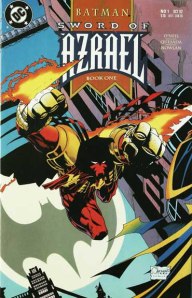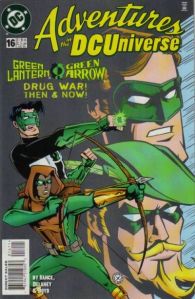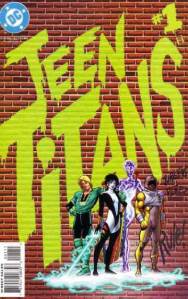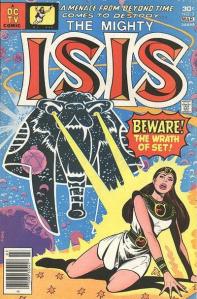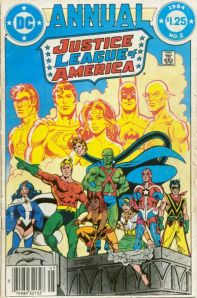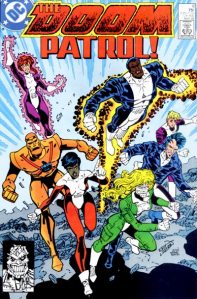This morning’s post features DC Heroes with October first appearances. We begin with two of the Seven Soldiers of Victory. That assemblage featured the stars of some of the longest-running (albeit third-tier) Golden Age DC strips: Vigilante, Shining Knight and Green Arrow. Today, we look at the lesser lights among the original Seven Soldiers.

Crimson Avenger: DC’s 80s answer to the gang busting pulp heroes of the Thirties, the Crimson Avenger was more recognisable in the bright costume he wore as one of Law’s Legionnaires. In common with the Green Hornet, Lee Travis was a newspaper editor with a horribly stereotypical Chinese chauffeur/sidekick, Wing.

Although he was killed off in a rather overrated Len Wein short, CA was revived in the 80s in retro stories by Roy Thomas. Idiosyncratically, Roy the Boy nicknamed him “The Crimson”, which makes as much sense as calling Norrin Radd “The Silver”. He was also cited as the inspiration for the Wes Dodds Sandman, DC’s first answer to the Green Hornet.
Grant Morrison introduced the JLA’s strange Masonic rite surrounding the Crimson’s original costume, since he was acknowledged as the first of the Mystery Men ( in the 90s at least).

Geoff Johns introduced a second CA in JSA: a gun-toting supernatural vigilante, this Crimson was like a black, female iteration of Ghost Rider. I’m surprised she isn’t part of the new Justice League of America.

Star-Spangled Kid & Stripsey : aside from the role reversal of sidekick and mentor, this teenage patriot -and his bruiser partner- are quite unappealing. SSK has a swanky moniker (Sylvester Pemberton) and a borrowed power-set ( a chunky Wally Wood belt incorporating Starman‘s cosmic rod technology). SSK was folded into the Justice Society in the Seventies, possibly because it was assumed Conway’s alien Mikaal Tomas might be a solo star(man). Sylvester founded Infinity Inc. in the Eighties and after about three or four years, he took on the identity of Skyman. Then he was murdered by Injustice Unlimited.
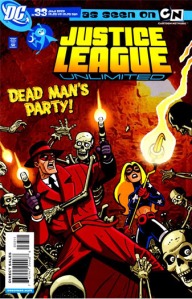
Geoff Johns introduced a second SSK ( later Stargirl). Courtney Whitmore was the perky stepdaughter of Stripesy. A modern version of the Kitty Pryde archetype, Stargirl has starred in Smallville and will be joining the aforementioned new JLA. The JLU all-ages title presented a witty Freaky Friday parody with Star and the Crimson. As you can see, the Green Hornet influence has been played up.
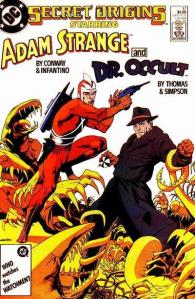
Dr.Occult: Siegel and Shuster’s mystical detective preceded Superman and even wore a caped costume which reversed Clark’s colours. “Doc Occ” and his Girl Friday, the literally-named Rose Psychic have a complex, pulpy backstory about a lost civilization and demon worship. Occult also totes a totem that reminds me of the Magic 8-Ball. I like the idea of a hardboiled shamus , a Philip Marlowe of the supernatural, much more than Mockney exorcist and darling of tattooed fanmen, John Constantine.

Tarantula: a cloaked version of the gold-and-purple Sandman whom I first discovered in the “Bureau of Missing Heroes” feature in a 70s issue of World’s Finest. Tarantula was reintroduced in All-Star Squadron, where, as an author of books on “Mystery Men”, he quickly became a “Mary Sue” figure for Roy Thomas. His pulp avenger redesign by Jerry Ordway is dynamic but is more 80s than 40s.

Flash ( Barry Allen): let’s be clear, there would have been no Silver Age without Carmine Infantino’s airy, elegant Scarlet Speedster. However, I find the sci-fi adventures of the Flash too polite and anodyne. My Flash-reading first took place in the 70s, when DC touched the series with the Relevancy brush: hippies, cultists and omniscient cosmic beings. Then the company modelled Barry on Peter Parker, destroying his domestic bliss. The true appeal of the series, however, lay in its assemblage of bizarre and characterful villains: Captains Cold and Boomerang, Mirror Master, the Trickster and the deathless Super-Gorilla Grodd.

Green Lantern (Hal Jordan): the appeal of the Green Lantern Corps, on the other hand, is the variety of bizarre and often charming aliens that comprise it. Despite the simple elegance and symbolism of the uniform ( the green of abundant life and growth contrasted with the black of deep space) Hal Jordan is a quaint New Frontier character. Echoing the pioneering pilots of the early space program, the Silver Age GL grabbed my imagination a couple of times in the 80s but I was never a great fan. This was possibly because of his uninspiring rogues gallery- the very opposite problem from Barry Allen.
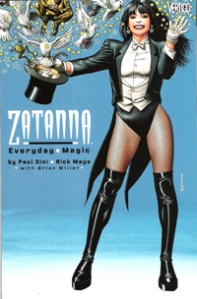
Zatanna: the winsome Maid of Magic was another character I first encountered as a guest in Len Wein’s World’s Finest stories. Her backwards-magic gimmick soon becomes a bit tired but it’s her faintly naughty stagewear that is the secret of her appeal. Gerry Conway treated her like DC’s answer to the Scarlet Witch and she was elevated to JLA membership, ultimately becoming chair of the League. However, she had to wear a couple of ugly sorceress costumes to do so.
In the Detroit League, Zee’s powers were reduced to element manipulation-the same frustratingly vague set as the Inhuman, Crystal. The Dini/Timm team revived her stage magician look and gave her a prominent role in the Bat-mythos and she had her own series in recent years. I expect the New 52 will give her comic- strip sexiness a sleazy spin.

Plastic Man: I didn’t know Plas was a Golden Age hero until the late 70s. I always knew him as a tongue-in-cheek comedy character who seemed to be relaunched from time to time with minimal success- like Captain Marvel. And like the Big Red Cheese, I’m very fond of Plas in my dotage. He ought to be regarded as one of DC’s iconic properties. Grant Morrison ( and Frank Miller, surprisingly) have made good use of his anarchic quality in the last decade-and-a half.

Deadman: apart from being one of the best- dressed heroes of the late Silver Age, the ludicrously-named Boston Brand is a wise-cracking, highly-strung character in the mighty Marvel manner. His embittered hipster dialogue recalls another Arnold Drake outsider, Cliff Steele. The Eastern mysticism which permeates what is essentially a noir series makes Boston DC’s first Beatnik superhero: the Kerouac of the spirit world.
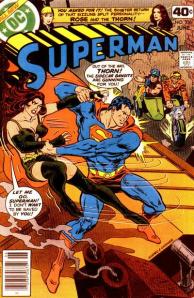
Rose and the Thorn: A gangbusting and fetishistic anti-heroine, the Thorn was an early Bronze Age revival of a Jay-Flash villainess. A riff on The Three Faces of Eve , the Thorn is the violent, rage-filled alternate personality of bereaved Rose Forrest. The concept has been revived from time to time, with a New 52 one-shot in the last few weeks. The Thorn’s dark, tormented persona is a neat fit in the angsty Noughties.

Flippa Dippa and the (second) Newsboy Legion: the first Fourth World comic I ever read featured this 70s revival of Jack Kirby’s wartime kid gang juxtaposed with a bizarre world of genetic engineering. To modern sensibilities, comic scuba diver Flip is an embarrassing stereotype. I can recognise the charm of the group however and it was highly logical to link them to reporter Jimmy Olsen.
Coming soon: More Mystery Men from the Bronze and Dark Ages
All images are presumed copyright of their respective owners







